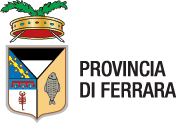Beyond the Windshield
From Corso Martiri della Libertà, the itinerary follows Corso della Giovecca, entering the area just south of Ferrara ‘Main Street’, to reach the imposing monumental arch of the Prospettiva
>>>Corso della Giovecca
This main road runs along the line that corresponded to the outer moat of the mediaeval fortifications, before the Erculean Addition was built—that is, the extension of the city of Ferrara towards the North, which began in 1492.
The beginning of the second of the Five Stories of Ferrara, that is The Stroll Before Dinner, literally introduces the reader to this street.
>>>DETOUR
Via Adelardi
This small road is found to the left of the Cathedral. In ancient times, it was called Via Gorgadello in reference to the whirlpools or eddies that formed in the city before the construction of drainage pipes and canals. At number 9 Via Adelardi, a plaque reminds us of the origins of what is considered the oldest tavern in the world, originally called Hostaria del Chiucchiolino. Giorgio Bassani locates the home of one of his most famous characters on this street: Dr. Fadigati, the protagonist of The Gold-Rimmed Spectacles.
>>>Via Savonarola
The present-day name of this street dates back to 7 February1860, arising from the building that was the childhood home of Girolamo Savonarola, the Dominican friar and preacher known for his political activities. Savonarola was ultimately hanged and his body was burned in Florence, and is memorialized by a statue located near the castle in Ferrara.
>>>Via Campofranco
The name of this narrow street arose from the fact that, in 1360, Marquis Aldobrandino d’Este legalized duels in Ferrara, excluding those who participated in them from prosecution, as if in a field of honour. Here you can discover the Poor Clares Church of Corpus Domini and part of the convent where Saint Catherine Vegri once lived, both built in 1415. Dukes Alfonso I, Ercole II, Alfonso II d’Este and the duchesses Lucrezia Borgia and Lucrezia d’Este are buried in the church.
>>>DETOUR
Via Salinguerra
The name of the street comes from the Ghibelline-allied Torelli Salinguerra family, who fought in Ferrara against the Guelphs between the 11 th and 13 th centuries. The Salinguerra family held on to power for a few decades, alternating with the Este family, who obtained definitive rule in 1264.
Bassani provides a detailed description of the route at the opening of the third chapter of Lida Mantovani, the first one of the Five Stories of Ferrara, a collection that earned the writer the Strega Prize in 1956. The author places the protagonist’s humble home there.
>>>Via Scandiana
Palazzo Schifanoia, the most famous delizia built by the Este family, complete with magnificent frescoes, is located on this street. Here, according to Girolamo Melchiorri, “weddings, parties, banquets and dancing were held, and ambassadors, princes, cardinals and bishops were welcomed”.
>>>Via Cisterna del Follo – Casa Bassani
Giorgio Bassani spent his childhood and adolescence in an old noble residence, together with his father Enrico, his mother Dora Minerbi and his younger siblings, Paolo and Jenny. He led a comfortable life between public school, gymnasium, private lessons in music or drawing, tennis at the Marfisa tennis club, skiing, and fencing.
A description of the building, between reality and fantasy, appears in the novel Behind the Door, although in the story the house is located in Via Scandiana.
>>>Tennis Club Marfisa d’Este
The engineer Carlo Savonuzzi designed four tennis courts with the entrance on Corso Giovecca. The club became a gathering place for Ferrara’s middle class. As well as Bassani, the partners include the film director Michelangelo Antonioni and the art historian Roberto Longhi.
>>>Corso della Giovecca – Prospettiva
At the end of the street is Palazzina Marfisa d’Este, a frescoed residence, built around 1559 by Francesco d’Este, the son of Duke Alfonso I and Lucrezia Borgia. Corso della Giovecca ends with the Prospettiva, a monumental arch with a scenic function, built by Francesco Mazzarelli between 1703 and 1704. The triumphal arch appears in one of Bassani’s most admired lyric poems, Rolls Royce.
Itinerary locations
last modified
Nov 25, 2024 10:41








